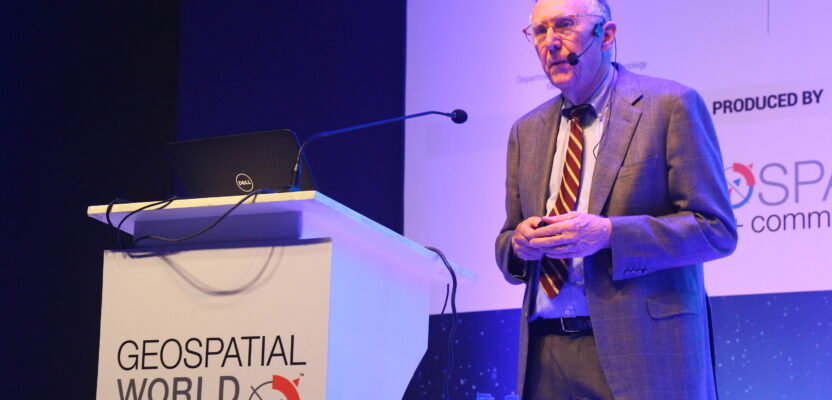At the Esri User Conference, xyHt European editor Nicholas Duggan sat down for a one-on-one interview with Jack Dangermond, Esri founder and CEO. In Duggan’s five-part online series, running each day this week, Dangermond discusses everything from Esri’s beginning to the future of GIS. Here in Part 3 the two discuss the impact of Covid-19.
Nicholas Duggan: Esri has changed quite a bit. I mean, obviously, it’s changed from 20 or 30yrs ago. What technological changes have you seen that have inspired you over the years?
Jack Dangermond: I don’t really know that there’s one. Somebody invented the wheel, and that was really amazing. That was a technological invention. Then somebody invented the bicycle. The bicycle is a tool that leverages the human body. It allows you to be able to move and travel, instead of walking or running, amazing technology. And the automobile builds on that. And so this whole invention idea continues to change our world.
When computers came along, it was the same thing. It was invented as a tool. When I got engaged with the first old mainframes, I had the thought that it wasn’t worth it; that the automation work that we were doing was kind of researchy and I found it really interesting. But I was curious about it, and I stayed with it. So then during the ‘70s as we went to many computers, it was really neat, because I saw how it could really could become a practical tool. That was the early days of GIS, then it took off.
When the Internet came, all these computers started getting interconnected, I mean, it was another sort of huge breakthrough, just like going from wheels to bikes to cars. So now, there’s this fabric of computers everywhere and so those have all been about leveraging and automation.
With GIS, there’s an element of maintaining systems of record. It leverages the computer, the amazing part of GIS. But the thing that gets me actually excited is the systems of insights that get created. Unlike other technologies, in the sense that it’s not just a tool, it’s also an instrument for creating human understanding. You might argue that’s advancing, you know, automating things, because lots of understanding just helps us get more efficient and helps us make better decisions.
GIS is unique and interesting because it also creates understanding. That’s a gift really. So, this excites me, because as we saw in the pandemic, we can actually create understanding at scale. We actually affected and impacted the entire world. We may help people understand what happened in Wuhan, and how it spread day to day, and I had people like the head of WHO tell me that he was jealous because their own ability to keep track of this was dwarfed by what Johns Hopkins and our team had actually done by pulling the data from many sources in a more ad hoc way, as opposed to the formal UN way. It woke up the world and it helped them understand that we are in the world together, that it’s all interconnected. It really was the inspiration for the [Esri] user conference themes. GIS is interconnecting our world and helps us to understand our world.
What we’re experiencing today with COVID is the beginning of a series of really incredible problems that we’re going to have to face and challenges that we must address. What I’m saying is that the technology of GIS is interesting, and it’s interesting because it’s creating understanding, not just automating something. The understanding that happened in COVID was of a social nature. It wasn’t just, “Oh, I did some experiments and now I can get some insights, and I can understand something.” What this caused is societal understanding and right now, just considering the political polarisation that goes on and is going on.
There are lots of mechanisms for communication, but actually creating understanding at global scale, like this, is a new chapter for us in our field. So, we went from projects to organizational understanding to societal understanding; from projects that create efficiency, to systems that create efficiency in organizations, digitally transforming organizations to the idea of digitally transforming society through understanding with data-driven understanding. Not political understanding, not our religious belief system on the right or the left but down the centre with fundamental information, on rational thinking.
This, to me, was a big deal this year and I don’t think there’s any going back on it. I also believe strongly that the GIS community demonstrated to the world [that] they don’t all work for anybody, all independently, using the same technology, redeployed the same ideas of dashboards, models, forecasts, and they sort of unanimously all took it on themselves independent of any single mission. You know, they do stuff beyond their missions, and they made advancements. So to me, that’s what I thought of when you asked about what technologies have surprised me.
What I just described, I wrote a paper on in 1981, on the evolution from projects to organizations to society. So I thought about it in those days, and this isn’t an ego thing, I kind of had a sense of what this might hold. And sure enough, it’s happened. You know how sometimes you have a vision. We all have lots of visions. You might even formalize your theory about a vision. But then when it actually shows up like this has done, it really is so motivating and reinforcing. Working with government organizations and NGOs around the world can actually make something happen. It gives me real hope that we have a shot, but we’ve got to work our ass off at this point to really make that happen.

